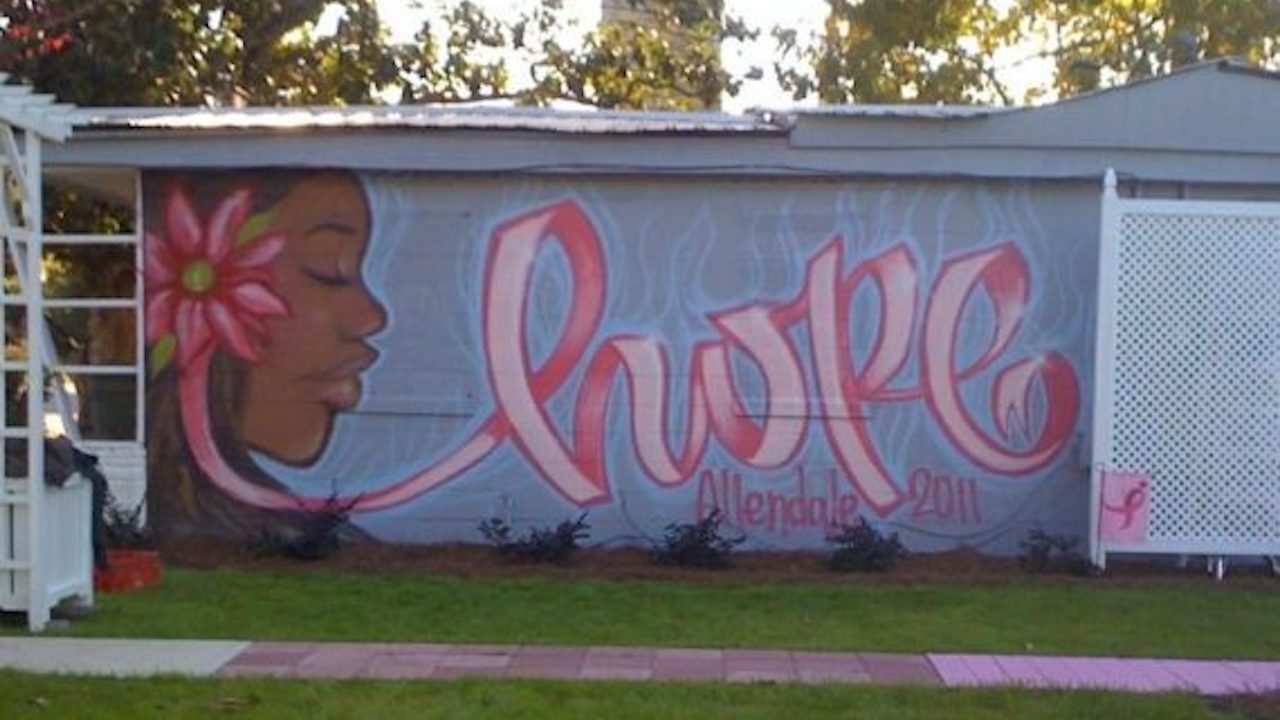
01 Dec Hope Allendale: Engaging through Art
 Last Sunday I departed from my comfortable, orange-leaf sheltered Greenville home and drove three hours south to Allendale, SC, the quintessential small town in the middle of nowhere. All I knew was there I would be joining an artist in painting a mural on a wall downtown. On my way I passed cotton fields that have receded shamefully into the nooks and crannies of South Carolina, arriving in a two-road town that is an odd mixture of beauty and decay.
Last Sunday I departed from my comfortable, orange-leaf sheltered Greenville home and drove three hours south to Allendale, SC, the quintessential small town in the middle of nowhere. All I knew was there I would be joining an artist in painting a mural on a wall downtown. On my way I passed cotton fields that have receded shamefully into the nooks and crannies of South Carolina, arriving in a two-road town that is an odd mixture of beauty and decay.
Hotels running along the palmetto-lined main streets are empty and boarded up, relics of Allendale’s glory days as a popular tourist stop en route to the ocean before the advent of the almighty Interstate. (A-la Radiator Springs in the film Cars.) Within a few hours of arrival, Joey Espinosa, a Greenville transplant, filled me in on some current news: townspeople were lobbying to restore one of the old hotels into the new Allendale town hall. The voting would take place on the following two days, the same days I was to join the Rodriguez family – Freedom, Nancy and kids – in painting the mural.
The morning after I arrived, Joey drove the Rodriquez’s and me to the mural site. It was a pristine, newly built and planted garden, the Pink Garden, dedicated to breast cancer victims and survivors. Freedom had designed a mural to paint on the side of a building bordering the park. His theme: Hope. On a paint-primed wall, he outlined profile of a strong woman with a flower in her hair. Out of the flower flowed a pink ribbon that looped and flowed out the word hope. I remember feeling surprised, as I took a spray paint can in hand, that the new garden itself was evidence of hope in Allendale. We were trying to inspire hope, but thankfully, there was hope to be found. Yet, I knew the residents of this p. 10,000 county were still in great need: they are victims and perpetrators of apathy, generational poverty, joblessness, homelessness, hunger. Allendale County schools are the worst in the state. The residents, the children especially, need hope.
Frank and Lottie Lewis pulled up as we began our work. They were driving separate cars, each busy with multiple obligations throughout the day: Lottie was helping figure out last minute lobbying techniques for the town hall vote – in favor! Frank was coordinating the planting of two hundred poppies alongside a new walking trail. This couple, also responsible for the new grass and sidewalks on which we stood in the Pink Garden, had hope for their town. What’s more, they were physically working out their hope that day – and still had time to take us all out to eat at a local soul food restaurant. They encouraged us with their gratitude and their anticipation of what we would be doing for the town.
As the image took shape, people began to stop their cars, shouting encouragement or simply honking. (Though it took the Rodriguez’s a little while to see the honking as friendliness, city-dwellers that they are.) One man, Oliver, walked up and introduced himself. He said the mural looked beautiful and would we be so kind as to explain the meaning? Freedom said that no matter the illness, or the trial, it was important, vital, to have hope. Oliver nodded his approval, tracing out the image with his eyes, comprehension on his face.
“Hope” loses its power and meaning for me when used in the same way as “I wish.” I use it, or mis-use it, in that way often, “hoping” that things will turn out ok. Yet as the image began to pop from the background, it became plain to me, and to Oliver I think, that the message was not one of “wish,” but of true hope: confidence, faith, anticipation. It takes this sort of hope to redirect the currents of a people caught in illness, sin, despair, and self-focus. I should know. And I’ve found the only way to hope with assurance is rooted in the Gospel: I have reconciliation with the source of true life, Father God, through the death and resurrection of Jesus Christ. God has given all believers this message to proclaim, this “ministry of reconciliation” (2 Corinthians 5:19).
This message can be proclaimed through the arts: music, dance, drama, all the things we have been created to enjoy and draw life from. The message is certainly proclaimed through friendships, particularly friendships with people who could be considered “enemies.” And this gospel is proclaimed when anyone chooses to speak the gospel into the life of another, and display it by meeting physical, spiritual, emotional needs. God is behind people moving toward each other in this way, a community of believers building each other up. He said, “Together, we are his house…And the cornerstone is Christ Jesus himself. We are carefully joined together in him, becoming a holy temple for the Lord.” (Ephesians 2:20-21)
I hope a new town hall is built in Allendale, but I have a sure hope that a house will be built. The Lord is building it even now. The people of Allendale should have hope: a Savior has come and he loves them. And I can have real confidence that any resource I give toward this house will be added by the expert builder, the author of all hope, Jesus.
-Lindsey Dryden
Grace Church Downtown Member



